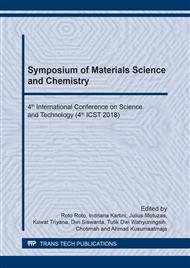p.159
p.169
p.175
p.181
p.186
p.192
p.198
p.206
p.212
Microfibrillated Cellulose Extraction from Bagasse Using a Modified Kitchen Blender
Abstract:
The extraction of microfibers from plant fibers can be obtained through specialized, expensive equipment that demands high energy input but delivering low production yields, resulting in highly costly microfibers. This situation confines the use of cellulose microfibers to the laboratory and not for industrial applications. The goal of this study is to extract microfibers from sugarcane bagasse (SCB) by using a kitchen blender. Earlier studies have demonstrated that paper sheets made of blender-extracted microfibers after 10 min blending have mechanical properties modulus comparable with commercially available cellulose microfibers extracted by a high-pressure homogenizer. By reducing the volume of aqueous suspension, resulting in higher tensile modulus to those of sheets made from commercially available cellulose microfibers. The FTIR analysis demonstrated that the treatments resulted in the gradual removal of lignin and hemicelluloses from the fiber. Morphological characterization identified that the diameter of the fibers varied between 20 nm to 12 µm. Finally, the high enough strength and comparable mechanical properties (modulus) of SCB microfibers to those of commercially cellulose microfibers, confirming their suitability in the manufacturing biomaterial composites.
Info:
Periodical:
Pages:
186-191
Citation:
Online since:
March 2019
Price:
Сopyright:
© 2019 Trans Tech Publications Ltd. All Rights Reserved
Share:
Citation:


